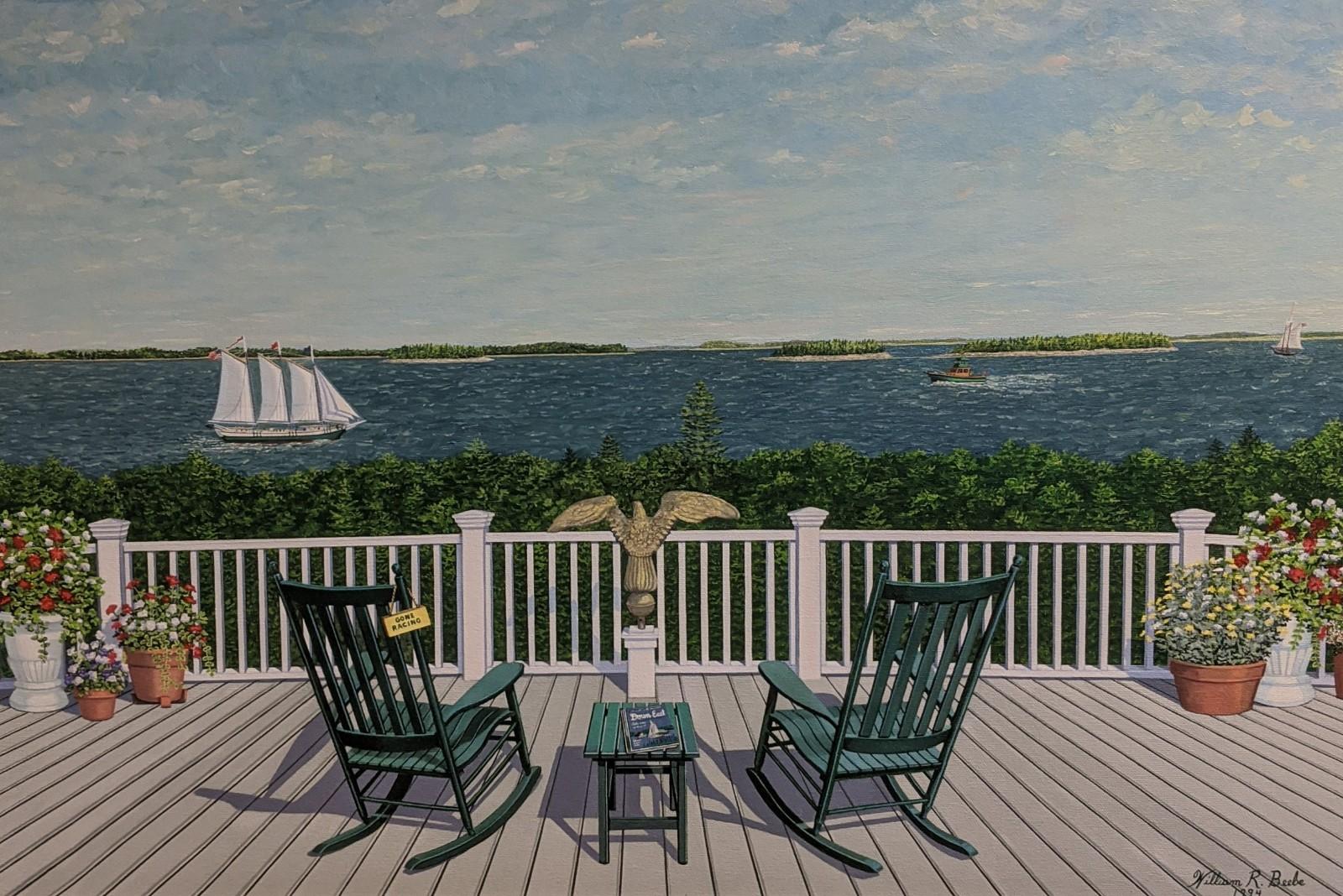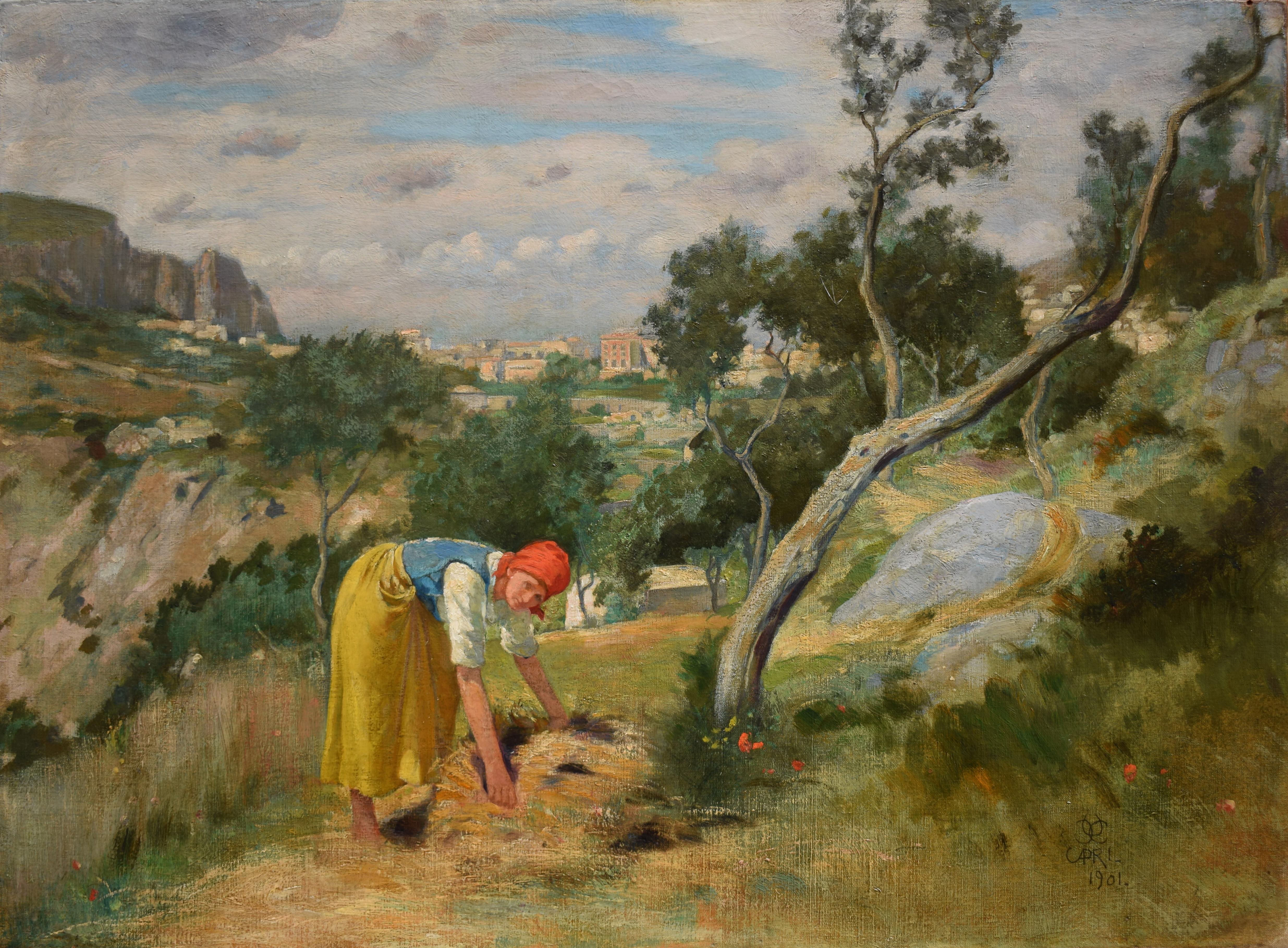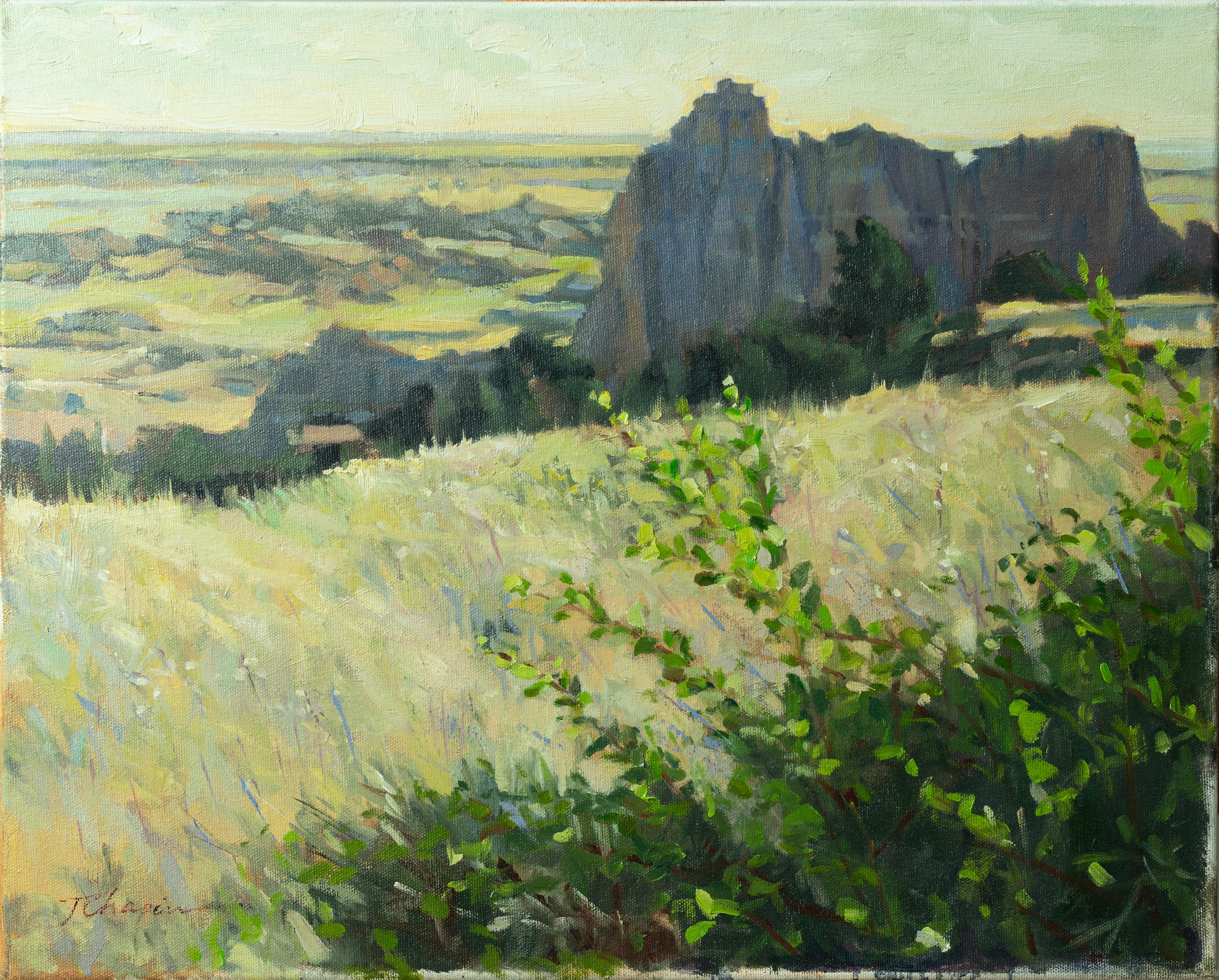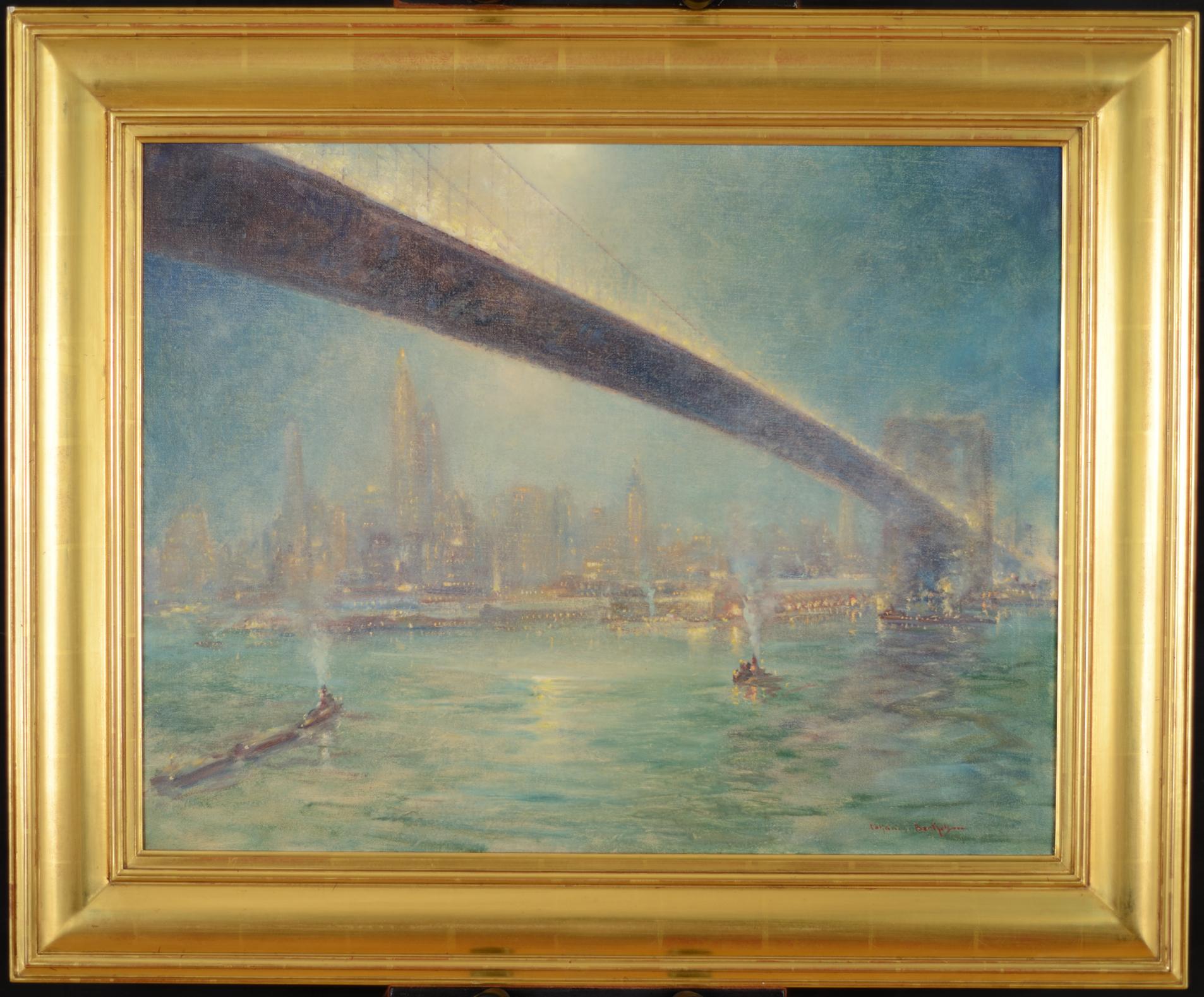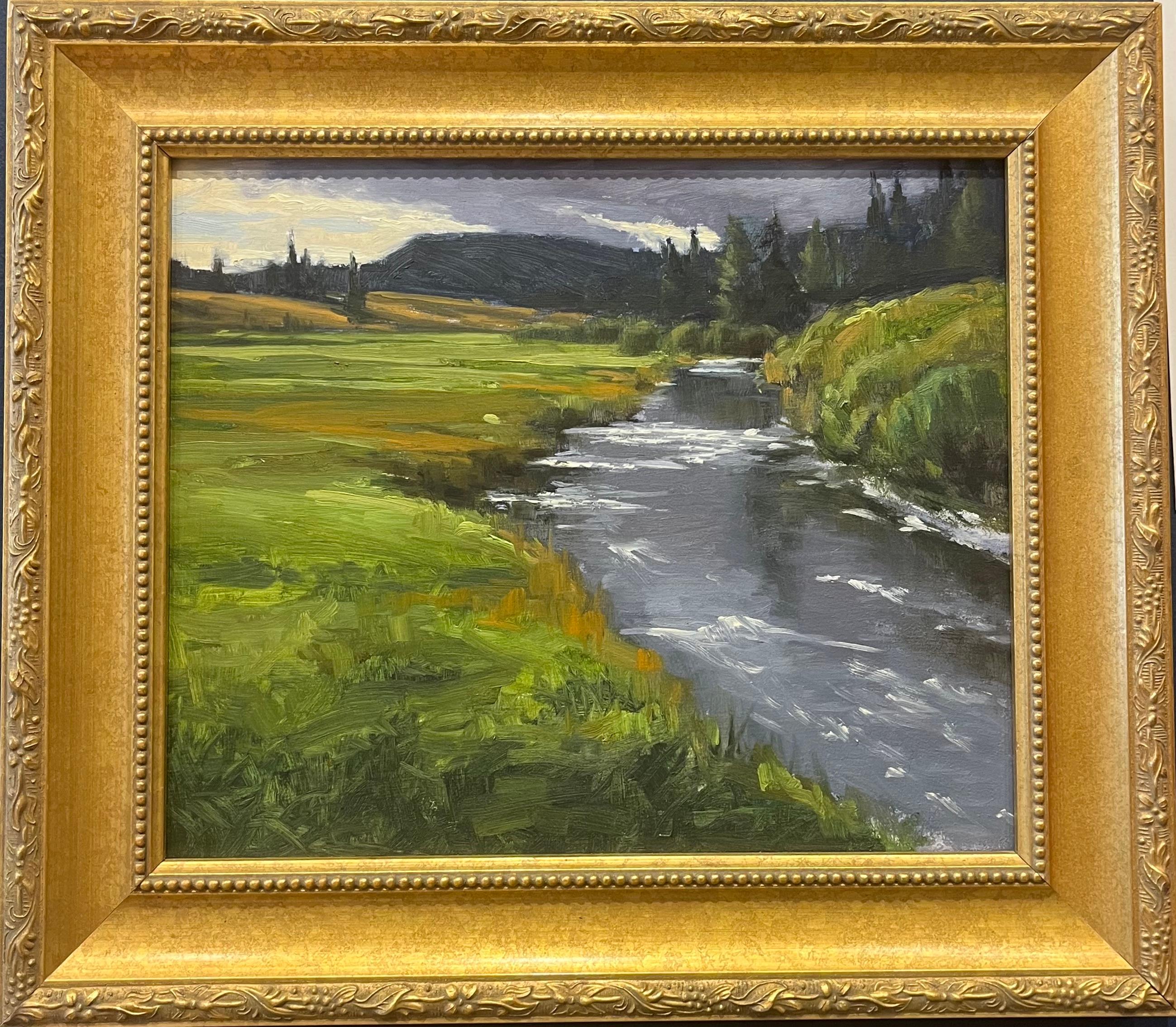Items Similar to Original James M. Hart
Want more images or videos?
Request additional images or videos from the seller
1 of 8
James MacDougal HartOriginal James M. Hart19th Century
19th Century
About the Item
James MacDougal Hart (American, 1828-1901)
Untitled (After Troyon), 19th century
Oil on canvas
18 1/16 x 30 1/16 in.
Framed: 31 1/2 x 40 1/2 in.
Signed lower right: James M Hart / After Troyon
Born in Kilmarnock, Scotland, James Hart was a leading figure of the second generation Hudson River School painters and was known for idyllic landscapes, especially with cows. His family emigrated to Albany, New York in 1830 when he was age two, and Hart, at age 15, apprenticed to a sign and banner painter in Albany. Later he switched to portrait painting.
At age 22, he went to Germany and enrolled in the Dusseldorf Art Academy for three years and returned to Albany where he opened a studio and taught and painted until 1857 when he established a studio in New York City. There members of the newly rich, post-Civil War society were delighted with his serene, rural landscapes. It was a time when New York "swarmed with people newly rich and feverishly eager to acquire at once the trappings and paraphernalia of culture, oil paintings included.
With such clients Hart and his brother, William, found abundant employment for their painting in a language intelligible to the artistically illiterate. James garnished his landscapes with barnyard animals, chiefly cows, and painted them with such fidelity that his delighted customers thought they could distinguish the Alderneys from the Guernseys."
His farm family teased him about his painting of farm animals, saying he knew little about them first hand. In the 1840s and 1850s, he also painted panoramic, luminous landscapes in meticulous details with many figures including farmers and children. The idea was to suggest that rural America was an idyllic place.
Of his cow paintings, G.W. Sheldon wrote in "American Painters": For cows and oxen, he has the fullest sympathy. Their thoughts which are not men's thoughts, their ways, which are not men's ways, and their faces which do not depend for interest upon any human likeness or suggestion, have been the objects of his studious love. He says that he likes cattle as well as landscapes---and this, for an artist like him, is saying a great deal." (50)
James McDougal Hart served as the Vice President for three years of the National Academy of Design. He was voted a full member in 1859.
His wife was artist Marie Theresa Gorsuch, a still-life painter, and their three children became artists: Robert Gorsuch Hart, Letitia Bonnet Hart, and Mary Theresa Hart.
Bio sourced from the Archives of AskArt
- Creator:James MacDougal Hart (1828 - 1901, British, American)
- Creation Year:19th Century
- Dimensions:Height: 31.5 in (80.01 cm)Width: 40.5 in (102.87 cm)Depth: 3 in (7.62 cm)
- Medium:
- Movement & Style:
- Period:
- Condition:Frame needs restoration, canvas slightly warped and minor craquelure consistent with age.
- Gallery Location:Larchmont, NY
- Reference Number:1stDibs: LU2211211879262
About the Seller
5.0
Gold Seller
These expertly vetted sellers are highly rated and consistently exceed customer expectations.
1stDibs seller since 2022
39 sales on 1stDibs
Typical response time: <1 hour
- ShippingRetrieving quote...Ships From: Larchmont, NY
- Return PolicyA return for this item may be initiated within 14 days of delivery.
More From This SellerView All
- Long Island Impressionist Pasture Scene by C.H. MillerBy Charles Henry MillerLocated in Larchmont, NYCharles Henry Miller (American, 1842-1922) The Road and The Ridge, c. late 1800s-early 1900s Oil on canvas 24 x 32 in. Signed lower left: Cha. H. Miller Inscribed verso: "The Road and The Ridge" Charles Henry Miller was a noted artist and painter of landscapes from Long Island, New York. The American poet Bayard Taylor called him, "The artistic discoverer of the little continent of Long Island." Miller was educated at Mount Washington Collegiate Institute, and graduated in medicine at the New York Homeopathic Institute in 1864. Before his graduation, he had occasionally painted pictures, and in 1860 he exhibited The Challenge Accepted at the National Academy of Design, in New York City. He lived in Queens at the summer estate, Queenslawn, originally purchased by his parents. He went abroad in 1864 and again in 1867, and was a pupil in the Bavarian Royal Academy at Munich under the instruction of Adolf Lier...Category
Early 20th Century American Impressionist Landscape Paintings
MaterialsCanvas, Oil
- Ernest Biddle New England Coastline Impressionist PaintingLocated in Larchmont, NYErnest Biddle (American, 1919-1970) Untitled Coastal Town, Likely New England, 20th century Oil on canvas 16 x 20 x 1/2 in. Signed lower left: Biddle The great grandson of the found...Category
20th Century American Impressionist Landscape Paintings
MaterialsOil, Canvas
- Charles Henry Miller Impressionist Landscape Oil PaintingBy Charles Henry MillerLocated in Larchmont, NYCharles Henry Miller (American, 1842-1922) Untitled (New York Landscape), c. 1900 Oil on canvas laid on foam 6 1/8 x 10 5/8 in. Signed lower left: C.H.M. Charles Henry Miller was a noted artist and painter of landscapes from Long Island, New York. The American poet Bayard Taylor called him, "The artistic discoverer of the little continent of Long Island." Miller was educated at Mount Washington Collegiate Institute, and graduated in medicine at the New York Homeopathic Institute in 1864. Before his graduation, he had occasionally painted pictures, and in 1860 he exhibited The Challenge Accepted at the National Academy of Design, in New York City. He lived in Queens at the summer estate, Queenslawn, originally purchased by his parents. He went abroad in 1864 and again in 1867, and was a pupil in the Bavarian Royal Academy at Munich under the instruction of Adolf Lier. After the 1874 death of his father, Jacob Miller, who was a wealthy architect and builder, Miller received a large inheritance that allowed him to paint as an independent artist for the remainder of his long life. He worked seriously and exhibited regularly, including at international exhibitions. The majority of his oil paintings depict Long Island subjects, especially those in and around Queens Village. Fed up with the development of the eastern part of Queens (present-day Nassau County), he began to spend part of his summers in East Marion, Long Island, c. 1910. Here he spent his time sketching and painting the surrounding areas. In 1885 he published The Philosophy of Art in America, using the pseudonym Carl De Muldor (he was descended from the De Muldor family). His work was recognized: in 1873, he was elected an associate of the National Academy of Design and an academician in 1875. He served as president of the New York Art Club in 1879 and of the American Committee at the Munich International Exposition in 1883. Legacy and honors • In 1910 Miller founded the Queens Borough Allied Arts & Crafts Society. • A New York City public school, Queens P.S. 33, was once named for him. • 1878, gold medal awarded by the Massachusetts Charitable Association • 1885, gold medal at the World's Exposition in New Orleans. Following is a list, which includes many of his known exhibitions: • National Academy of Design, New York, NY, 1860-61, 1865-67, 1870-1921 • Brooklyn Art Association, Brooklyn, NY, 1872-84, 1891-92 • Artist's Fund Society, New York, NY, 1874 (exhibition & sale), 1886 (exhibition & sale) • Century Association, New York, NY, (1874-1917) • Philadelphia Centennial Exhibition, Philadelphia, PA, 1876 (prize) • Society of American Artists, New York, NY, (1878-1882) • Massachusetts Charitable Mechanic Association, Boston, MA, 1878 (prize) • Paris International Exposition, Paris, France, 1878, 1889 • American Water Color Society Exhibition, New York, NY, 1879 • Pennsylvania Academy of Fine Arts, Philadelphia , PA, 1879-99 • Boston Art Club, Boston, MA, 1880-1907 (prize) • Union League Club, New York, NY, 1880 • Lotos Club, New York, NY, 1880, 1896, 1899-1900, 1906 • Salons of Paris, Paris, France, 1882 • International Exhibition, Munich, Germany, 1883 (president & exhibitor) • New Orleans Exposition, New Orleans, LA, 1885 (prize) • Art Institute of Chicago, Chicago, IL, 1888-89, 1891, 1894-98, 1904 • Fifth Avenue Art Gallery, New York, NY, 1889 (exhibition & sale) • World's Columbian Exposition, Chicago, IL, 1892 • Frederick A. Chapman Gallery, New York, NY, 1898 (solo) • Miller Studio...Category
Early 20th Century American Impressionist Landscape Paintings
MaterialsFoam, Oil, Canvas
- Impressionist Painting of Cows and Trees by C.H. Miller, Long IslandBy Charles Henry MillerLocated in Larchmont, NYCharles Henry Miller (American, 1842-1922) Untitled (Cows and Trees), c, 1885 Oil on canvas 18 x 24 in. Signed lower left: Chas. H. Miller, N.A. Charles Henry Miller was a noted artist and painter of landscapes from Long Island, New York. The American poet Bayard Taylor called him, "The artistic discoverer of the little continent of Long Island." Miller was educated at Mount Washington Collegiate Institute, and graduated in medicine at the New York Homeopathic Institute in 1864. Before his graduation, he had occasionally painted pictures, and in 1860 he exhibited The Challenge Accepted at the National Academy of Design, in New York City. He lived in Queens at the summer estate, Queenslawn, originally purchased by his parents. He went abroad in 1864 and again in 1867, and was a pupil in the Bavarian Royal Academy at Munich under the instruction of Adolf Lier...Category
1880s American Impressionist Landscape Paintings
MaterialsCanvas, Oil
- Impressionist Painting of French coast, St. Tropez, by Frederick FrederLocated in Larchmont, NYFrederick Freder (American, 1895-1954) St. Tropez, France, 1921 Oil on canvas 26 x 32 in. Framed: 32 x 38 in. Signed verso: Frederick C. Freder, The Palm Tree, Saint Tropez, St. Trop...Category
1920s American Impressionist Landscape Paintings
MaterialsCanvas, Oil
- Charles Henry Miller Hudson River School landscape of Queens, NYBy Charles Henry MillerLocated in Larchmont, NYCharles Henry Miller (American, 1842-1922) Untitled, c. Late 1800s-Early 1900s Oil on board 9 x 12 in. Framed: 14 5/8 x 17 3/4 in. Signed lower right: C.H. Miller Charles Henry Miller was a noted artist and painter of landscapes from Long Island, New York. The American poet Bayard Taylor called him, "The artistic discoverer of the little continent of Long Island." Miller was educated at Mount Washington Collegiate Institute, and graduated in medicine at the New York Homeopathic Institute in 1864. Before his graduation, he had occasionally painted pictures, and in 1860 he exhibited The Challenge Accepted at the National Academy of Design, in New York City. He lived in Queens at the summer estate, Queenslawn, originally purchased by his parents. He went abroad in 1864 and again in 1867, and was a pupil in the Bavarian Royal Academy at Munich under the instruction of Adolf Lier. After the 1874 death of his father, Jacob Miller, who was a wealthy architect and builder, Miller received a large inheritance that allowed him to paint as an independent artist for the remainder of his long life. He worked seriously and exhibited regularly, including at international exhibitions. The majority of his oil paintings depict Long Island subjects, especially those in and around Queens Village. Fed up with the development of the eastern part of Queens (present-day Nassau County), he began to spend part of his summers in East Marion, Long Island, c. 1910. Here he spent his time sketching and painting the surrounding areas. In 1885 he published The Philosophy of Art in America, using the pseudonym Carl De Muldor (he was descended from the De Muldor family). His work was recognized: in 1873, he was elected an associate of the National Academy of Design and an academician in 1875. He served as president of the New York Art Club in 1879 and of the American Committee at the Munich International Exposition in 1883. Legacy and honors • In 1910 Miller founded the Queens Borough Allied Arts & Crafts Society. • A New York City public school, Queens P.S. 33, was once named for him. • 1878, gold medal awarded by the Massachusetts Charitable Association • 1885, gold medal at the World's Exposition in New Orleans. Following is a list, which includes many of his known exhibitions: • National Academy of Design, New York, NY, 1860-61, 1865-67, 1870-1921 • Brooklyn Art Association, Brooklyn, NY, 1872-84, 1891-92 • Artist's Fund Society, New York, NY, 1874 (exhibition & sale), 1886 (exhibition & sale) • Century Association, New York, NY, (1874-1917) • Philadelphia Centennial Exhibition, Philadelphia, PA, 1876 (prize) • Society of American Artists, New York, NY, (1878-1882) • Massachusetts Charitable Mechanic Association, Boston, MA, 1878 (prize) • Paris International Exposition, Paris, France, 1878, 1889 • American Water Color Society Exhibition, New York, NY, 1879 • Pennsylvania Academy of Fine Arts, Philadelphia , PA, 1879-99 • Boston Art Club, Boston, MA, 1880-1907 (prize) • Union League Club, New York, NY, 1880 • Lotos Club, New York, NY, 1880, 1896, 1899-1900, 1906 • Salons of Paris, Paris, France, 1882 • International Exhibition, Munich, Germany, 1883 (president & exhibitor) • New Orleans Exposition, New Orleans, LA, 1885 (prize) • Art Institute of Chicago, Chicago, IL, 1888-89, 1891, 1894-98, 1904 • Fifth Avenue Art Gallery, New York, NY, 1889 (exhibition & sale) • World's Columbian Exposition, Chicago, IL, 1892 • Frederick A. Chapman Gallery, New York, NY, 1898 (solo) • Miller Studio...Category
Early 20th Century American Impressionist Landscape Paintings
MaterialsCanvas, Foam, Oil
You May Also Like
- Deck of FoxhillLocated in Greenville, DEMarine scene from the deck of a Maine estate (Foxhill). William Beebe considers himself a Creative Realist, using touches of impressionism to go beyond representation. This particula...Category
20th Century American Impressionist Landscape Paintings
MaterialsOil, Canvas
- Peasant woman at work in the fields of CapriBy Charles Caryl ColemanLocated in Roma, RMCharles Caryl Coleman (Buffalo 1840 – Capri 1928), Peasant woman at work in the fields of Capri (1901) Oil painting on canvas 35 x 49 cm, signed, located and dated Capri 1901 lower ...Category
Early 1900s American Impressionist Landscape Paintings
MaterialsCanvas, Oil
- Badlands (South Dakota) - Plein Air Landscape painting green yellow colorsBy Jane ChapinLocated in Cody, WYThis is a 'Plein Air" landscape Painting by Jane Chapin as seen in the viewing room exhibition on Silas VON MORISSE GALLERY. “Plein-Air” is the French expression to describe the act...Category
2010s American Impressionist Landscape Paintings
MaterialsCanvas, Oil
- The Pond, Godfrey's Pond, Batavia, New York, Stafford, American LandscapeLocated in Grand Rapids, MIStuart E. Zillman (American, 20th Century) Signed: Stuart E. Zillman (Lower, Right) " The Pond ", c. 1960s (Possibly Godfrey's Pond) Oil on Canvas Board 16" x 20" Housed in a 1...Category
Mid-20th Century American Impressionist Landscape Paintings
MaterialsCanvas, Oil
- Bridge Nocturne oil painting by Johann BerthelsenBy Johann Berthelsen, 1883-1972Located in Hudson, NYOne of Johann Berthelsen's iconic nocturne views of New York City across the Hudson River. Bridge Nocturne (c.1945) Oil on canvas, 22" x 28" 29 ½" x 36" x 2" framed Signed "Johann ...Category
1940s American Impressionist Landscape Paintings
MaterialsCanvas, Oil
- Oil River and Mountain LandscapeLocated in Fredericksburg, VAThis oil on canvas landscape painting depicts a grassy river scene with mountains in the distance. The brushstrokes are very representative of the impressionist movement, but the col...Category
Late 20th Century American Impressionist Landscape Paintings
MaterialsCanvas, Oil
